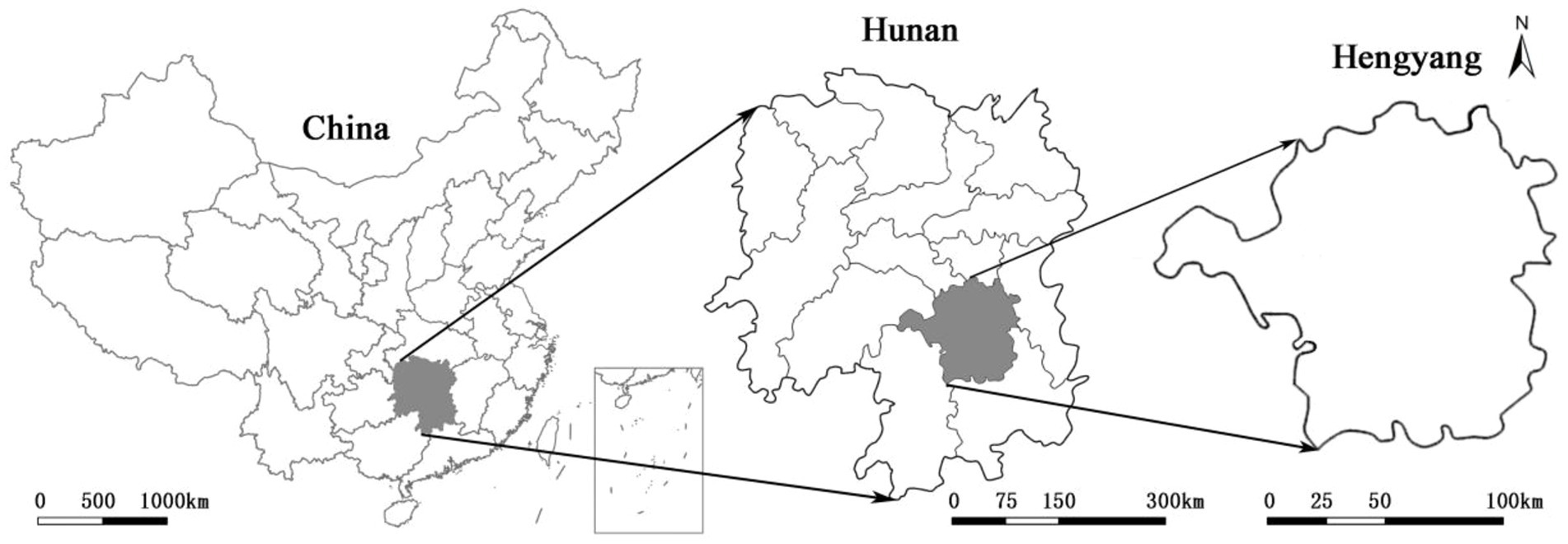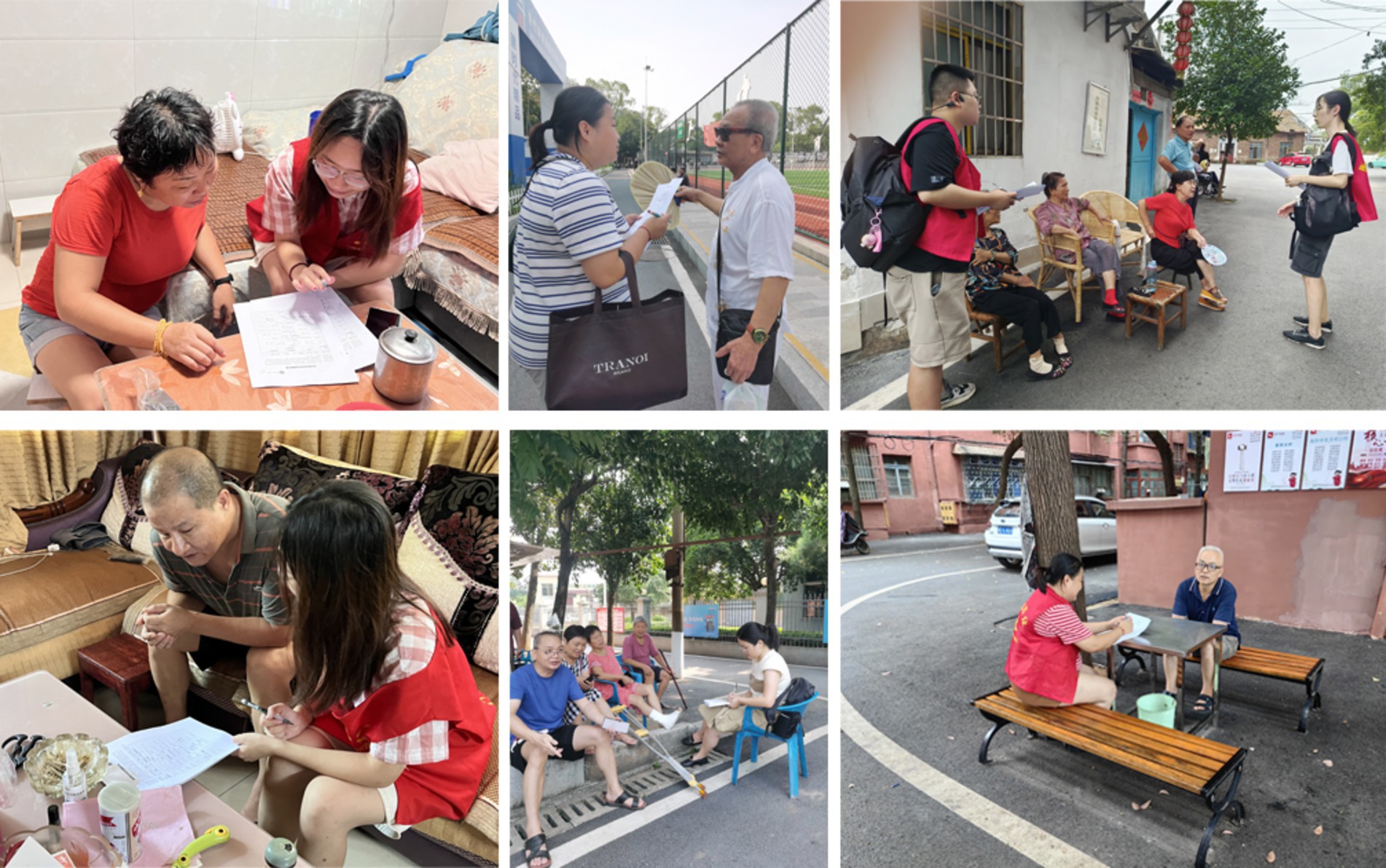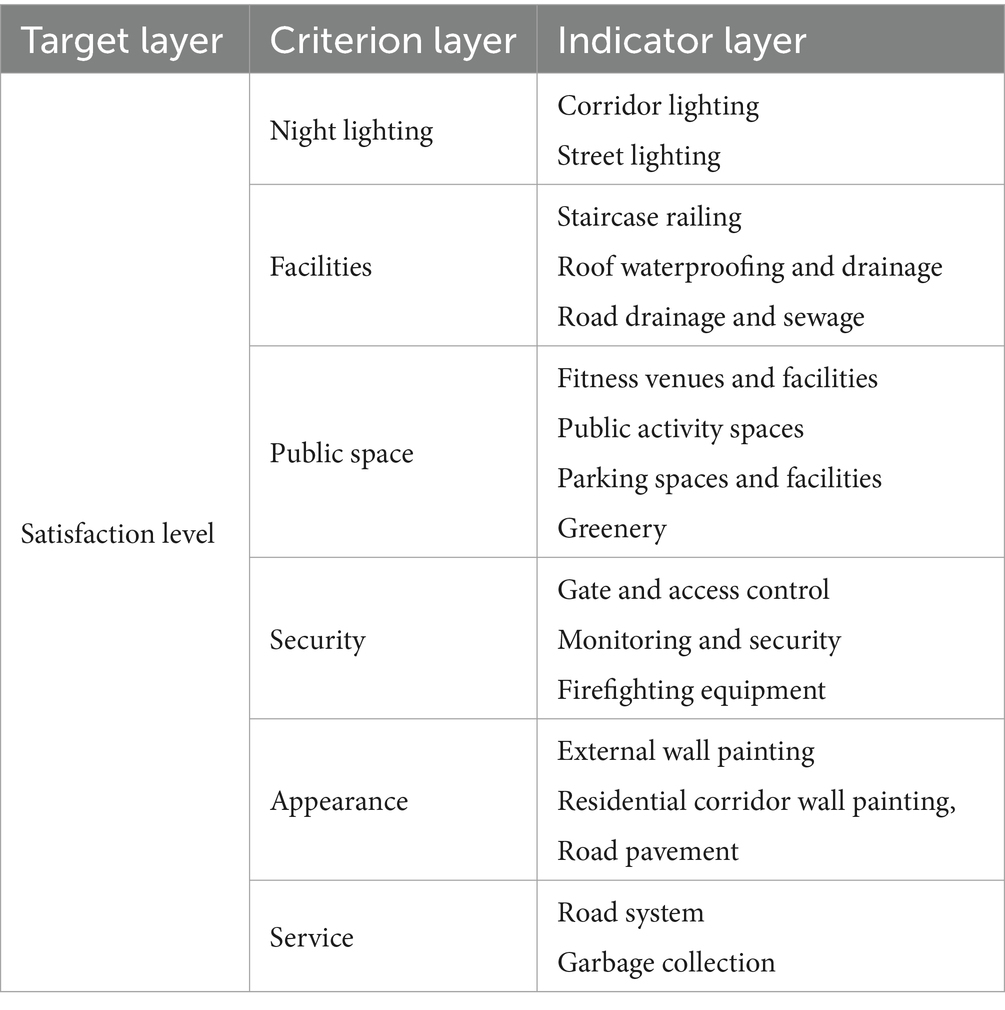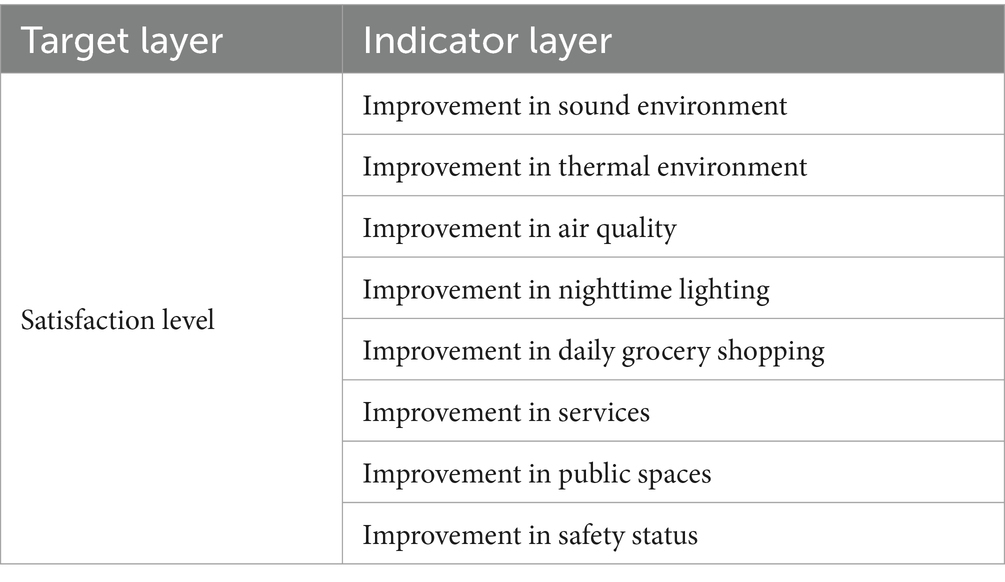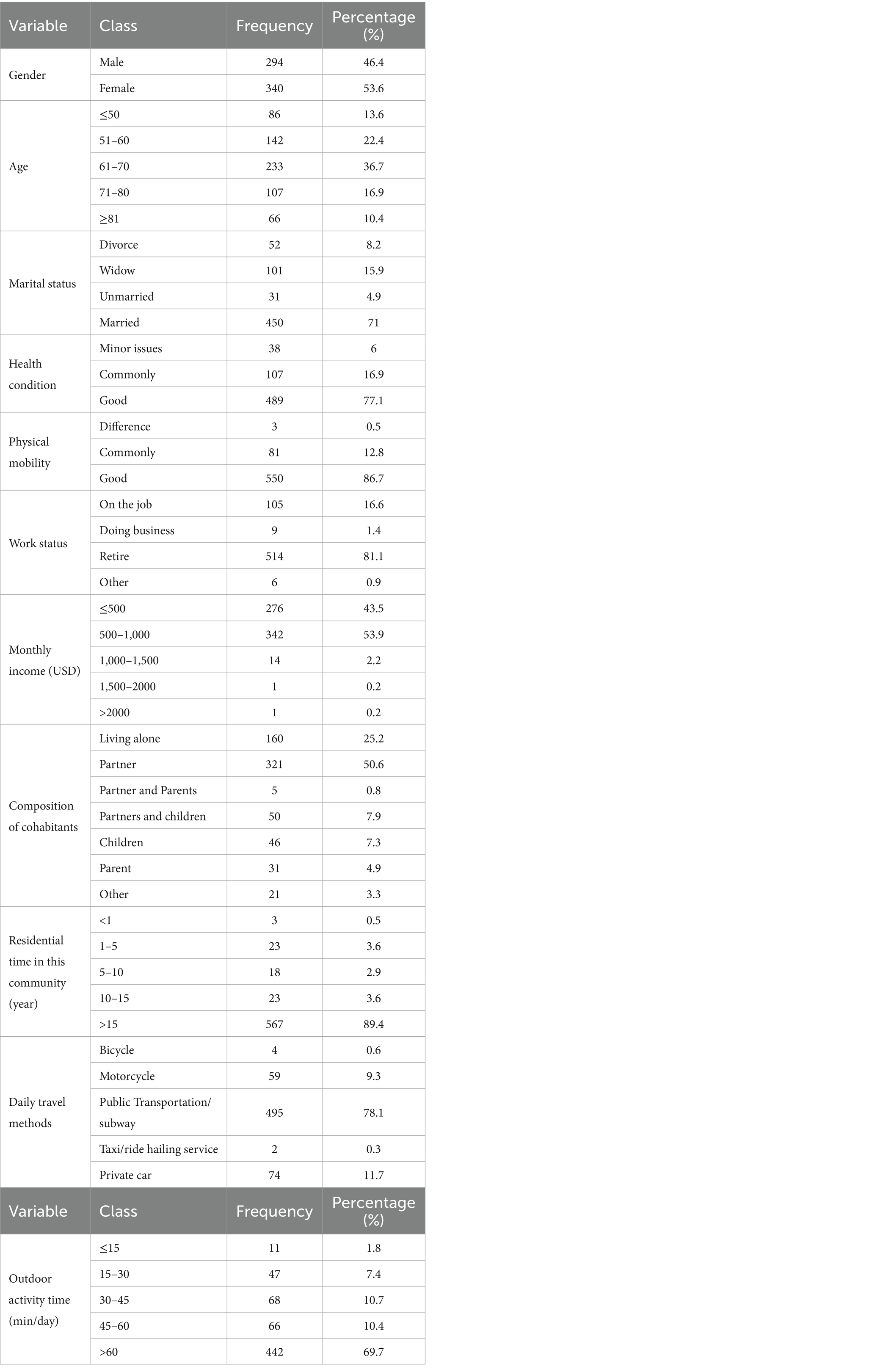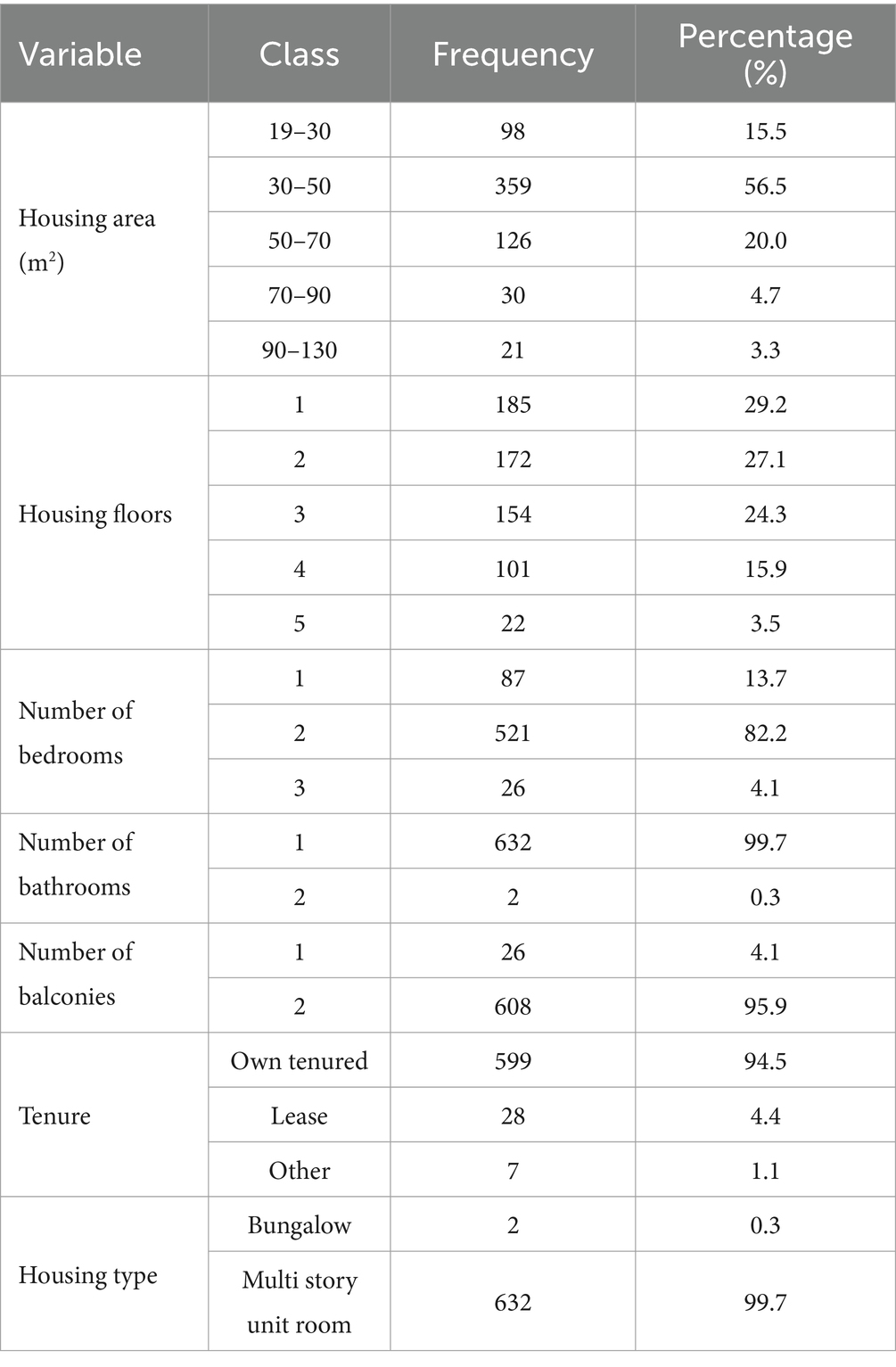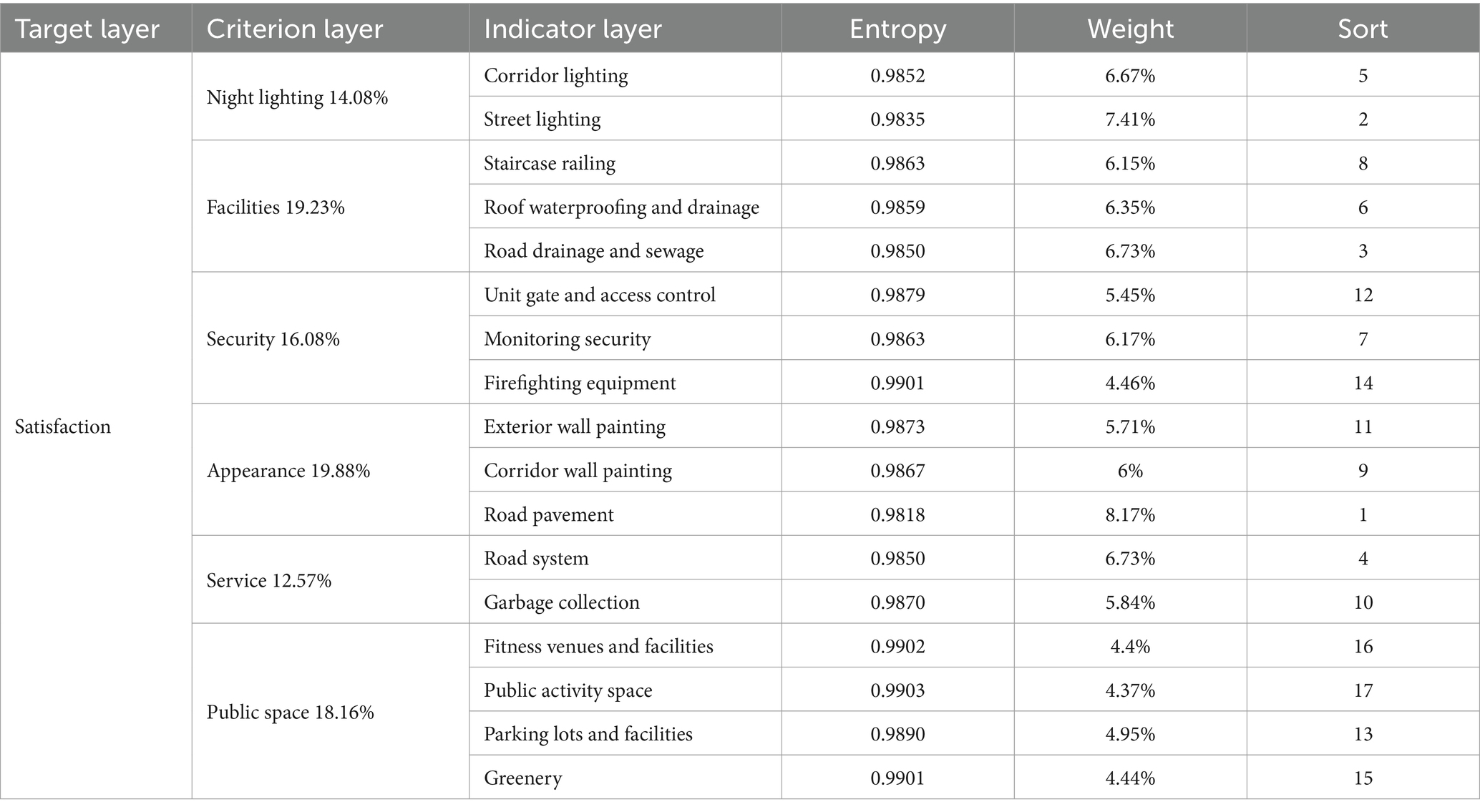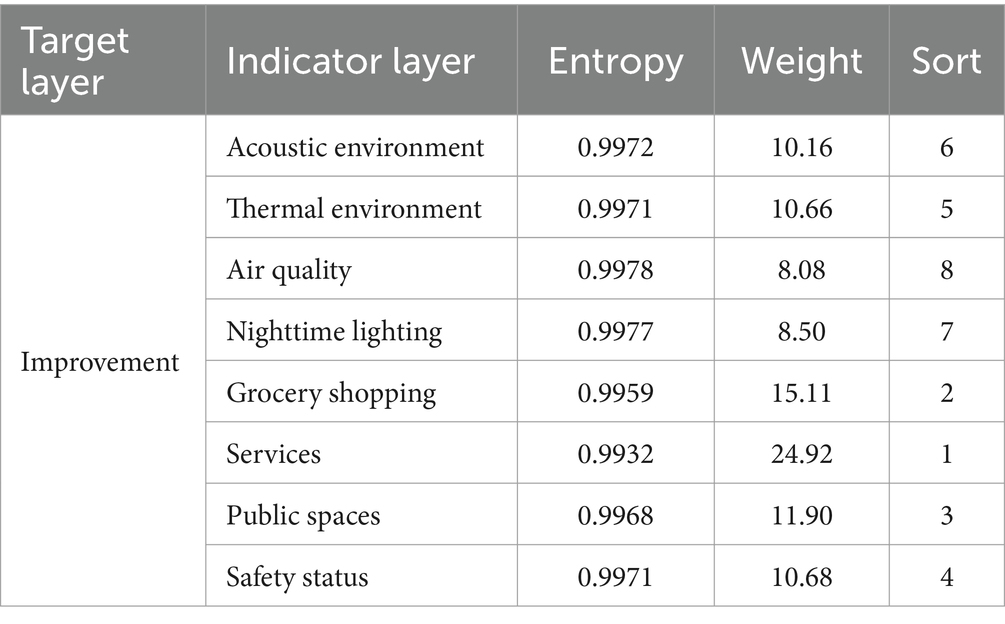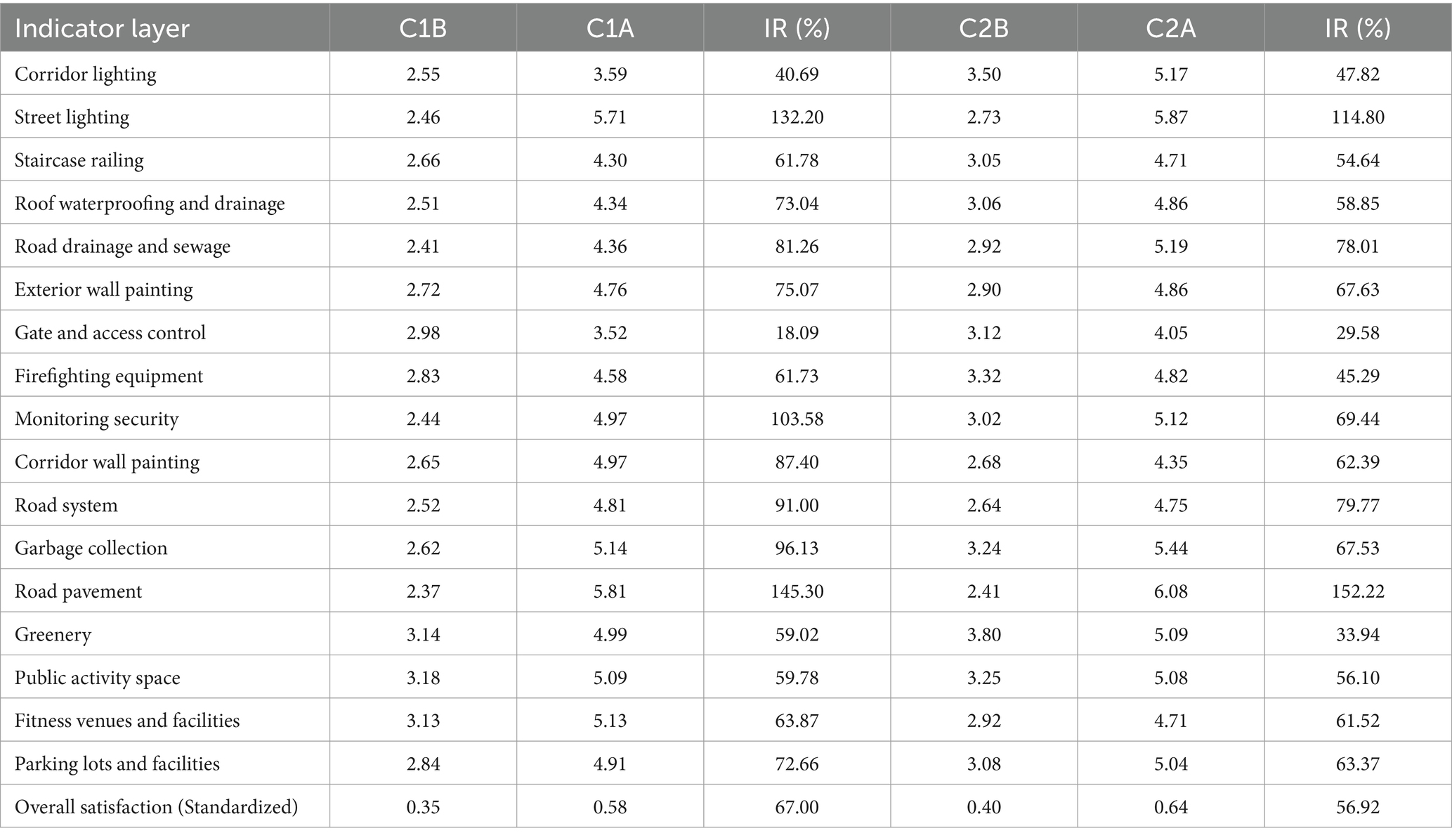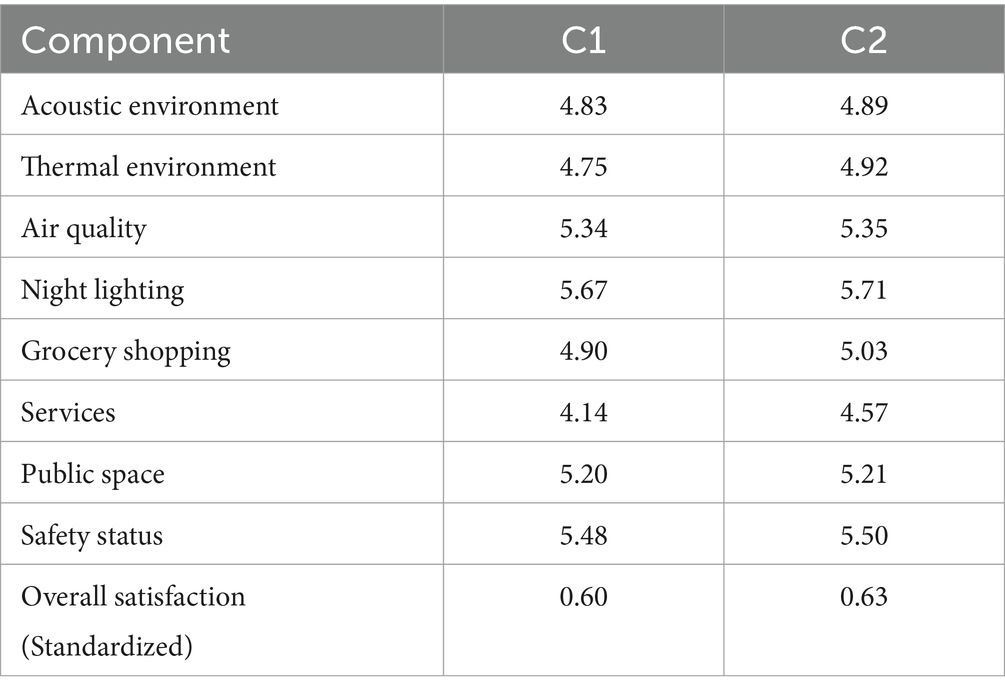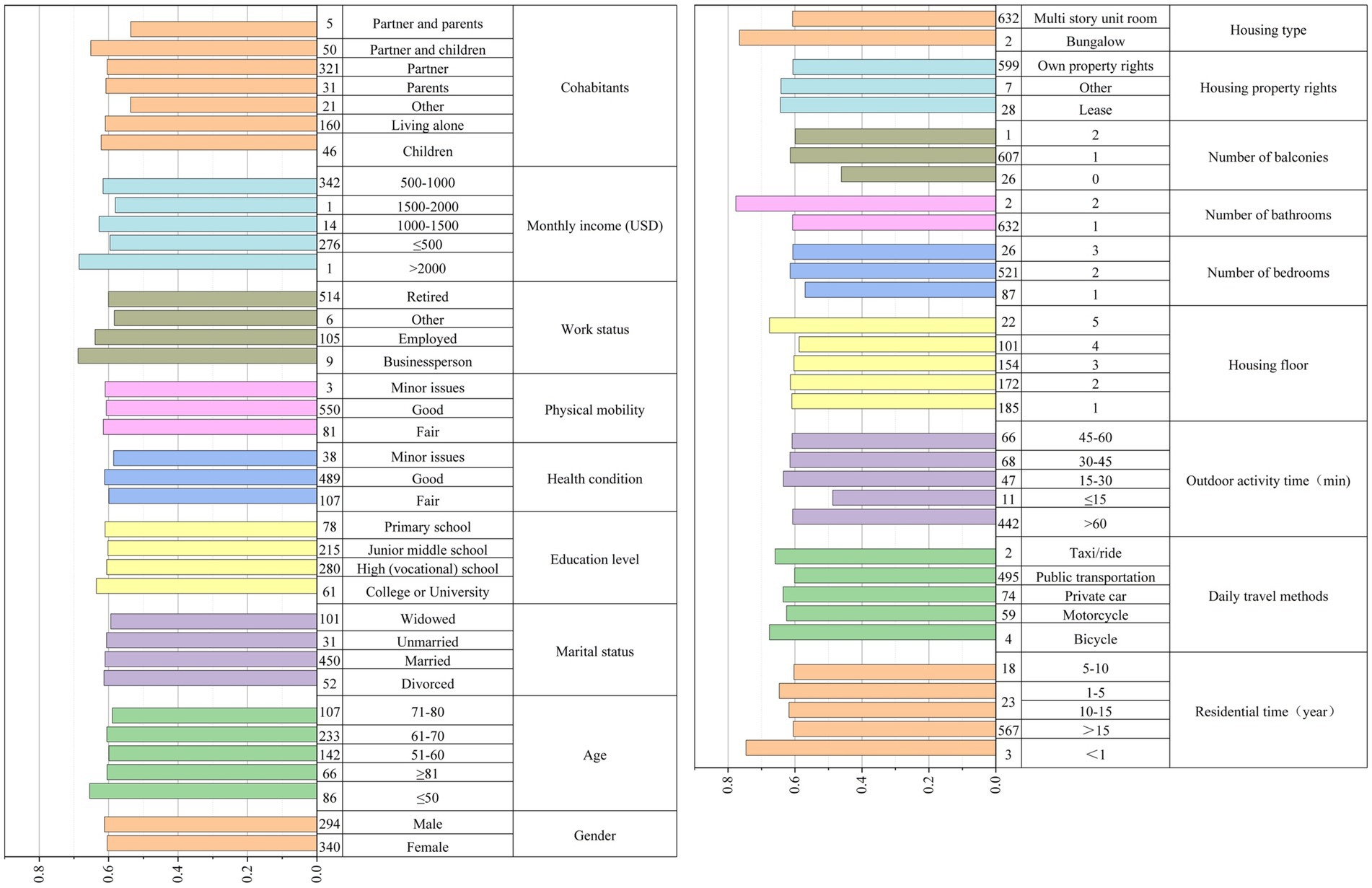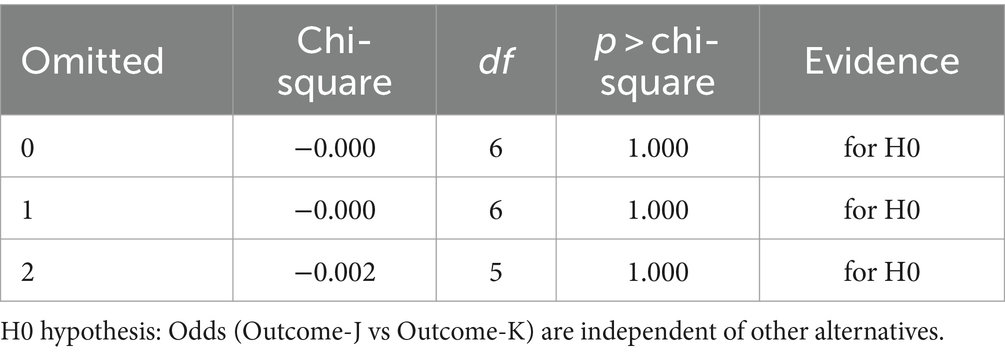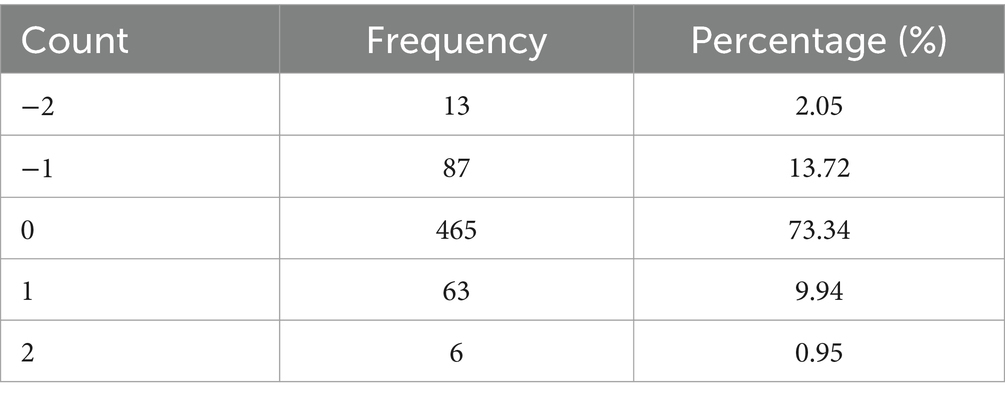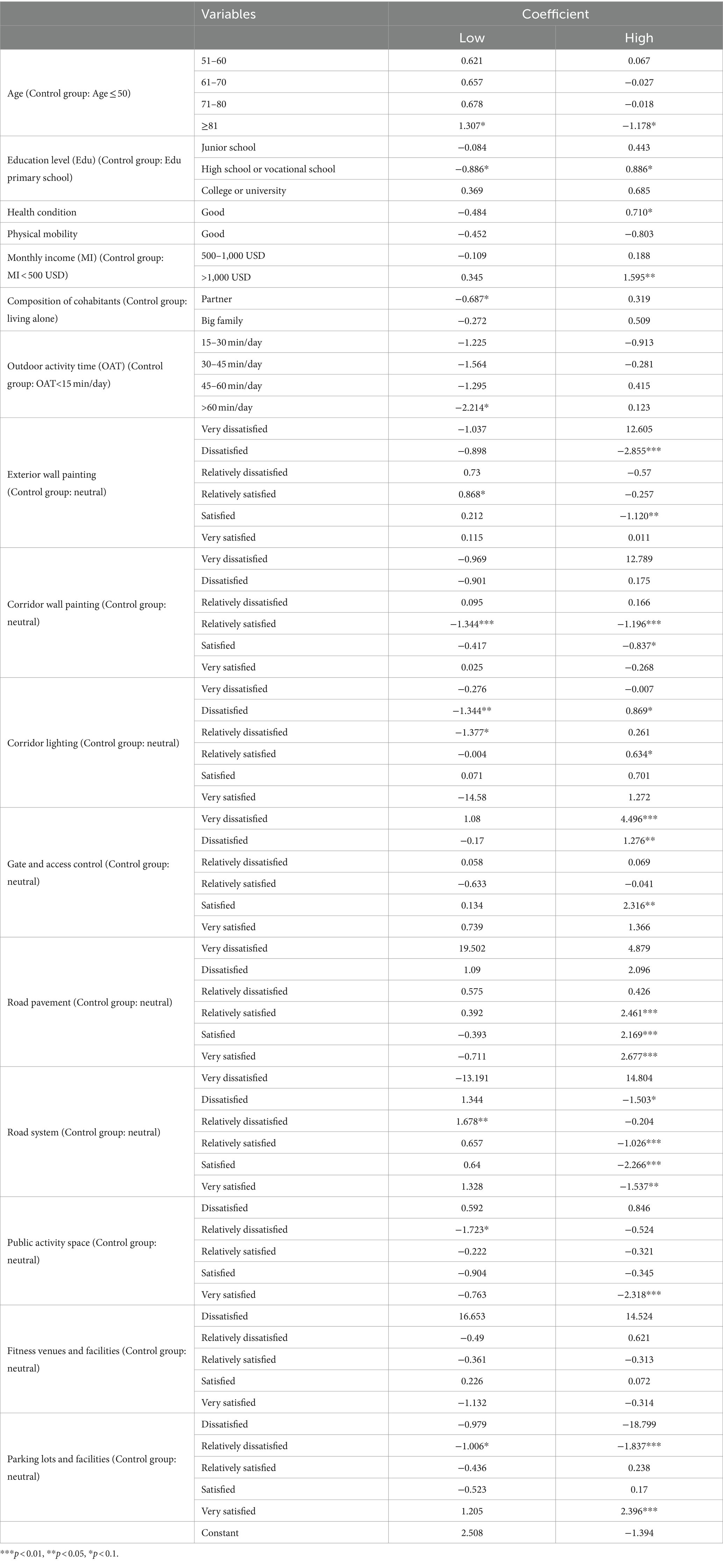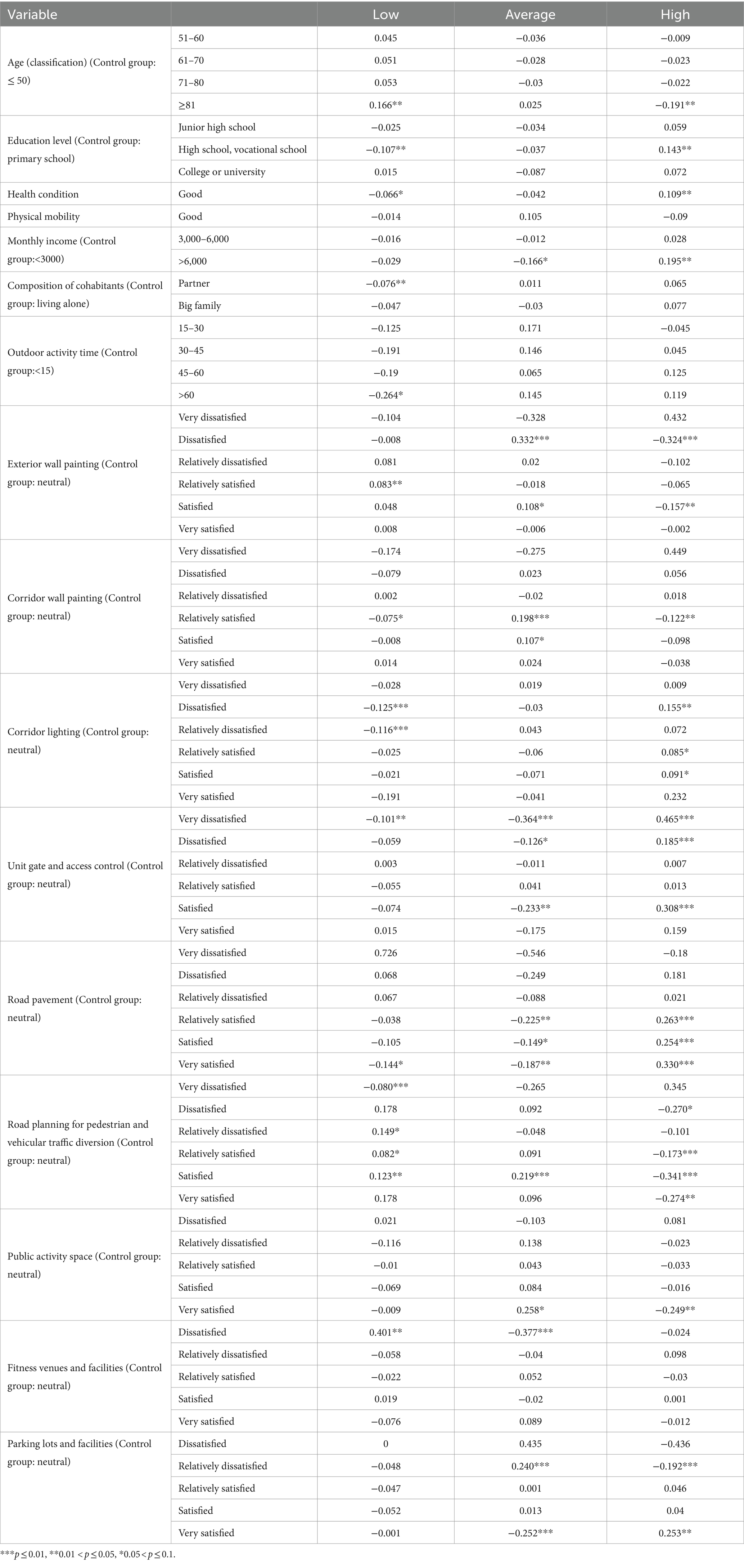- 1The School of Architecture and Art, Central South University, Changsha, China
- 2School of Architecture, South China University of Technology, Guangzhou, China
- 3Urban Planning and Transportation, Department of the Built Environment, Eindhoven University of Technology, Eindhoven, Netherlands
- 4Urban and Data Science Lab, Graduate School of Advanced Science and Engineering, Hiroshima University, Higashi Hiroshima, Japan
Introduction: Danwei communities are a testament to China’s socialist urban development, characterized by the self-sufficiency, strong social networks, and institutional management. In the historical context of urban development in China, many old communities have evolved from former housing areas of Danwei. After more than 40 years of use, the buildings, and environments in the old Danwei communities remain in disrepair, dirty, disorderly and poor condition. Many functions have failed that negatively affect the quality of life and health of residents. After Covid-19, improving the mental health of residents has become a major goal of public policies in various countries.
Methods: To explore the residents’ mental health in the micro-renewal, this study carried out a survey regarding residents’ evaluation on the micro-renewal and their mental health in two renewed Danwei communities in Hengyang, China. More than 800 respondents joined the interview, among them, 634 samples are effective for analysis. Entropy-TOPSIS is applied to analyze the weights of various indicators of micro-renewal. And multinominal logit model is used to examine the relationship between the personal factors, satisfaction on various items of micro-renewal and mental health.
Results and Discussion: The findings indicates that the mental health level of residents living in Danwei community is affected by micro-renewal. The socio-demographic characteristics and behavior factors can influence on the possibility of being in different levels of mental health. The satisfaction on the components of micro-renewal and improvements after micro-renewal is also determiner of residents’ mental health level. In addition, the heterogeneity is address in mental health.
1 Introduction
The rapid and unplanned urbanization is one of the main ecological and human challenges in the 21st century (1). The instability of the urban system has been intensified along with climate change and environmental deteriorating through the increasing anthropological activities. The World Health Organization (WHO) put forward the initiative aiming at improving the health and well-being of urban population through participatory and multi-sectoral urban governance by 2028, and proposed that health does not start from hospitals or clinics, but from our families and communities (2). To support the sustainability in economic and social development and improve the environmental quality and population’s health in urban areas, urban renewal has been carried out in various ways all over the world (3–8).
The urbanization process in China has been significantly accelerated in the last decades. The population living in cities was about 69.79 million in 1978, which accounted for 17.9% of the total population in China at that time. By the end of 2022, this proportion increased to 65.22%, in other words, more than 920 million population in China is living in cities now. However, in the wake of urban development and population growth, the shortcomings are becoming apparent in the existing large number of old communities (3, 9). These old communities were typically built by state-owned enterprises, government departments, and public institutions to house their employees and their families. The term “Danwei” refers to all these organizations that provided employment, housing and various social services to its members. Danwei has been the principal social organizational form in Chinese socio-economic contexts until the beginning of 21st century (10–13).
The old Danwei communities in China, once the cornerstone of socialist urban development, are now facing significant challenges as they age. There is a serious quality conflict between old Danwei communities and new communities, which exacerbates social inequality in housing and hinders sustainable urban development (10). Compared with newly built communities, there are limitations such as incomplete supporting facilities, serious illegal constructions, and insufficient parking spaces. Moreover, after more than 40 years of use, the buildings in the old communities remain in disrepair, dirty, disorderly and poor condition. Many functions have failed that negatively affect the quality of life of residents and impact on their health. Such physical conditions of old Danwei communities can significantly affect residents’ mental well-being (11). Living in poorly maintained environments can lead to feelings of helplessness and despair, exacerbating stress and anxiety (12). The lack of investment in these communities also means that essential services, such as sanitation and waste management, are often subpar, further degrading the living conditions and contributing to the residents’ mental strain. The residents, especially the older adults and children, find themselves confined to environments that do not support their developmental and social needs, leading to increased incidences of depression (13). Perhaps one of the most insidious issues facing residents of old Danwei communities is social isolation. As these communities were originally built for the employees of specific factories or institutions, the social fabric was once tightly knit. However, with the closure of many of these workplaces and the outmigration of younger populations, the remaining residents often find themselves isolated. The breakdown of these social networks means that many residents, particularly the older adults, experience loneliness, which has been strongly linked to poor mental health outcomes (14–16).
In recent years, to achieve fair health and social outcomes, the renewal of old residential community has become the key part of urban renewal where the obvious population aggregation, regionality and symbiosis exist (10, 17, 18). Improving the mental health of residents has become a major goal of public policies in various countries, especially in urban and rural development policies. The local government, scholars and urban planning and public health experts have been exploring ways to improve residents’ mental health through the intervention of old residential community renewal (8, 19–22). Based on literature regarding the research on urban renewal, the large-scale demolition and renovation are not suitable model for resilience of old Danwei communities.
An innovative renovation measure was firstly proposed as “Micro-renewal” by urban renewal bureau of Guangzhou in 2016. Compared with the large-scale and government led renovation model, it is a people-oriented urban renewal model with minor rebuild (23). Compared to reconstruction, micro renovation is less likely to disrupt residents’ neighborhood attachment (24). At the same time, micro renovations contribute to the sustainable protection of living heritage, helping old Danwei communities retain their historical and collective memory related features and values while seeking development and adaptation (25). The micro-renewal, as an innovative approach, has been implemented in urban redevelopment (26, 27). It is the adjustment and functional replacement of the environment and suitable for places with inconsistent usage and poor environmental conditions (26).
The participation in planning and design of community renewal can affect residents’ sense of empowerment, thereby achieving higher health benefits (Baba, Kearns, McIntosh, Tannahill and Lewsey) (28). The focus of public participation is to safeguard the interests and demands of the public as well as the public interests of the community. Therefore, the impacts of public participation in micro-renewal of old Danwei communities on the mental health of residents are reflected in two aspects. On the one hand, micro-renewal can change the quality and appearance of houses and community, potentially affecting the emotions of residents; on the other hand, residents can promote the goal of amending the environment of community closer to their needs through public participation, while also improving their sense of belonging and cohesion toward the community, thereby enhancing their mental health and sense of happiness in life.
To explore the residents’ mental health in the renovation of old residential areas, self-assessment of their expected mental health is necessary (29). However, current research on urban renovation and resilience mainly focuses on quantifying the improvement of the physical environment and the psychological satisfaction of residents after renovation. Limited empirical evidence on the improvement of residents’ psychological health through urban renewal, especially microscale renovation, was presented (6, 20). It is necessary to extend the residents’ assessments on the improvements in micro-renewal with a reasonable self-assessment of the mental health for fully understanding the effects of micro-renewal of neighborhood. To achieve this goal, this study, therefore, takes two old Danwei community micro-renewal projects as cases to investigate the potential impacts of neighborhood renovation on the mental health of residents. The key variables in that affect the mental health of residents was identified to construct a comprehensive framework for post occupancy evaluation in neighborhood micro-renewal. The findings are expected to guide the sustainable development of old Danwei community in contexts of Chinese cities.
This study is aiming to examine the nature and strength of the relationships between residents’ satisfaction on neighborhood scale renewal and their mental health. The conceptual framework of post occupancy evaluation advocates that the transformation of the architectural environment will have an impact on the actual living experience of residents in various aspects in terms of environment, architecture, and resources, as well as personal psychology. Accordingly, the implementation of old Danwei community micro-renewal may affect the psychological health of residents through changes in different dimensions such as residential conditions, community environment, community safety, esthetics, and quality of activity venues, etc. The satisfaction evaluation which measures the benefits generated by micro-renewal can be obtained from the field surveys on residents. Therefore, this study proposes an innovative framework of “public participation-micro-renewal of old community-residents’ mental health.” The analysis framework links objective living conditions with mental health through micro-renewal of old Danwei communities and makes public participation an important prerequisite for the implementation of micro renovation projects.
2 Literature review
Urban renewal has been a significant focus of urban planning and public health research for decades, driven by the need to address the challenges posed by aging urban infrastructure, particularly in rapidly urbanizing countries like China. The old Danwei communities have become increasingly problematic, which are characterized by deteriorating infrastructure, outdated facilities, and an aging population, which together contribute to a range of social and health-related issues.
Previous studies have established a clear link between the quality of the built environment and mental health outcomes. Evans discusses how poor housing conditions, including inadequate lighting, poor ventilation, and structural decay, can exacerbate stress and anxiety among residents (30). Galea et al. further emphasize that living in deteriorating environments can lead to increased incidences of depression, particularly in low-income populations that lack the resources to move to better housing (13).
The inadequacy of facilities in aging communities has also been well documented. Li and Wu highlight that in many of China’s older urban neighborhoods, including Danwei communities, the lack of modern amenities such as healthcare services, recreational spaces, and social services severely impacts residents’ quality of life (15). This deficiency is particularly acute for the older adults, who are more dependent on local services for their daily needs. The absence of adequate facilities not only limits physical health but also contributes to social isolation, further exacerbating mental health issues.
Social isolation has been identified as a critical factor influencing mental health, particularly in older populations. Cacioppo and Cacioppo discuss the “toxic effects” of perceived social isolation, which can lead to increased risks of depression and anxiety (16). In the context of Danwei communities, where the social fabric has been eroded due to the outmigration of younger populations and the closure of many original workplaces, the remaining residents often find themselves isolated. This social isolation is compounded by the physical deterioration of the environment, creating a feedback loop that further degrades residents’ mental health.
Recent studies on urban renewal have begun to explore the potential benefits of interventions such as micro-renewal in improving both the physical environment and the mental health of residents (17, 31). Micro-renewal, as an innovative approach, focuses on small-scale, community-driven improvements that can enhance living conditions without the disruption associated with large-scale redevelopment. Zhao et al. provide a comprehensive analysis of micro-renewal projects across China, demonstrating their potential to improve residents’ quality of life by addressing both physical and social dimensions of urban living (23). Sheng et al. clarified the relationship between the development of urban community cultural heritage and the consolidation of local residents’ cultural identity (32). Tian et al. explored the role of participatory electronic planning models in old residential area renewal projects (33). Considering that the ultimate goal of renovating old residential areas is to improve the living conditions, health status, and well-being of residents, and achieve sustainable development, evaluating the impact of micro renovation projects on residents is the focus of research (31, 34). Liu and Li established 32-item index for five aspects, including politics, economy, culture, society, and ecology (26). Wang et al. established a 16-element index in terms of the benefits of government, resident, and developer, and constructed a comprehensive evaluation model for decision-making on urban renewal mode selection (35). Riera Pérez et al. developed a spatial decision support system for neighborhood-scale renewal projects which takes the actual situation of old community and the expected long-term resilience into account (36).
While there is substantial literature on the general impacts of urban renewal, there is limited empirical research specifically focusing on the mental health outcomes of micro-renewal in old Danwei communities. Most existing studies either address the physical improvements brought by urban renewal or discuss mental health in broader terms, without linking these two aspects in a comprehensive framework. This study aims to fill this gap by investigating how micro-renewal in old Danwei communities affects residents’ mental health. The research question guiding this study is: “How does micro-renewal impact the mental health of residents in old Danwei communities, and what are the key factors that mediate this relationship?”
By addressing this research question, the study aims to contribute to the growing body of knowledge on urban renewal and public health, offering insights that can inform future policy and practice in the renewal of aging urban communities.
3 Methodology
3.1 Data collection
The data collection was conducted in Hengyang, Hunan Province, China. By the end of 2022, there were more than 6.5 million permanent population living in Hengyang, which is the second largest city in Hunan Province. Hengyang is one of the important industrial cities in the central south of China (see Figure 1). Since the reform and opening up in China, many manufactures have been established in Hengyang. The thriving industry in the 1970s and 1980s had attracted a large population and built massive Danwei residential communities. At present, the communities left over from the planned economy era become outdated, incomplete functional facilities, low per capita land area, and poor environmental quality. However, these old Danwei communities preserve the collective memories of different generations and contain unique cultural values, making them unsuitable for major demolition and renovation. Therefore, it is urgent to apply micro-renewal to update them. The typical cases of renovations in Hengyang are suitable for studies on the mental health of residents after micro-renewal. In August 2023, a one-on-one questionnaire survey was conducted among all residents of two old Danwei communities in Hengyang, namely, Baizhuzao and Xinkuangcun. Baizhuzao community is the residential area of the former state-owned enterprise, which is classified as Community 1 (C1), and. Xinkuangcun community is the residential areas of a cable factory and a plastic factory which is classified as Community 2 (C2).
Baizhuzao is a residential area originally built by a former state-owned enterprise. It represents a typical old Danwei community where the majority of the infrastructure has significantly aged, and the social structure is relatively homogeneous. The community’s residents largely consist of retired workers who have lived in the area for decades, making it an ideal case to study the impacts of micro-renewal on a population that is deeply attached to its living environment and highly affected by changes in it. Xinkuangcun, on the other hand, is a residential area associated with a cable factory and a plastic factory, showcasing a different industrial background and a somewhat more diverse social structure. This community, while also an old Danwei community, has experienced different patterns of urban development and resident demographics compared to Baizhuzao. This diversity allows for a comparative analysis of how micro-renewal impacts communities with varying social dynamics and histories.
The questionnaire consists of questions regarding respondents’ personal basic information, housing conditions, psychological health assessment, and satisfaction on micro-renewal of the old Danwei communities. The Short Warwick Edinburgh Mental Well-being Scale (SWEMWBS) was used for examining the respondents’ mental health (34). SWEMWBS has been extensively validated and can be used in various regions, languages, and cultural backgrounds, as well as in various built environment projects. The scale has a total of 14 items, with a rating range of 1–5 points for each item. The total score for each item is calculated by adding up the total score (ranging from 14 to 70 points). This study used K-means clustering to input the scores of each item in each sample, and ultimately divided the scores into high, average, and low mental health. Among them, the score range for groups with low mental health levels is “32–51″, the score range for groups with average mental health levels is “49–60″, and the score range for groups with high mental health levels is “60–70″. Respondents’ subjective evaluation was estimated by the Likert 7-point scale.
Before the field investigation, seven research assistants were trained to ensure consistency and accuracy in data collection, and how to administer the questionnaire, handle respondents’ queries, and record responses accurately. A random sampling method was used to select participants. The sampling frame included all households in the two old Danwei communities, where improvements were made to residential buildings and urban surroundings, ensuring that every resident had a known and non-zero chance of being selected. During the survey, we also got some help from the neighborhood management commission to invite residents to join in the interview. The scenes of interviews are shown in Figure 2.
The structured interview was carried out at convenient locations for residents, such as community centers, public spaces, or respondents’ homes if they preferred. Each interview takes approximately 20 min. Interviews were conducted face-to-face, with trained interviewers asking standardized questions to evaluate residents’ perceptions and mental health outcomes. During the survey, the interviewer explained the questionnaire to the interviewee to ensure they could understand and answer accurately. The total number of households in two communities is 1,261 (C1:936, C2:325). After a two-week (from 10th to 23rd August 2023) on-site survey, a total of 634 (503 in C1 and 131 in C2) effective questionnaires were collected.
3.2 Entropy-TOPSIS
The effectiveness of micro-renewal is mainly manifested in improving living conditions, optimizing outdoor environments, enhancing public services, and optimizing infrastructure. To analyze its effect on mental health of residents in depth, this study constructs an evaluation model with indicators regarding satisfaction on six key renewed components, including night lighting, facility, public space, safety, style and service. In this model, each component is characterized with specific measured items, which are shown in Table 1. In addition, the level of satisfaction of residents toward the improvements of micro-renewal is listed in Table 2.
The method of modeling applied in this study combines Technique for Order Preference by Similarity to Ideal Solution (TOPSIS) and Entropy weight, namely Entropy-TOPSIS. As a multicriteria decision making method, the basic concept of TOPSIS is that the chosen alternative should have the shortest distance from the ideal solution and the farthest distance from the negative ideal solution. The Entropy-TOPSIS uses entropy value to determine the weights of various indicators and calculates the optimal and worst solutions of each evaluation object through TOPSIS. The concept of entropy originates from thermodynamics and is used to quantify the degree of chaos in a system. It can better reflect the interrelationships between the dimensions of comprehensive satisfaction and agreement. In this study, the weight of indicator is determined by the amount of information it provided. The larger the amount of information, the greater the utility of the indicator in the decision-making process. This method lies in determining the positive ideal solution (D+) and the negative ideal solution (D-), and then calculating the geometric distance between each alternative solution and these ideal solutions, characterizing the relative closeness of the evaluation object to the optimal solution, providing an intuitive and quantitative indicator for evaluating the effectiveness of micro-renewal in old Danwei communities. The steps are presented as follows:
Step 1: To establish a decision matrix.
An evaluation matrix consisting of m samples and n evaluation indicators.
where, i is the sample size, and j is the number of indicators. In Equations 1 and 2 of this study, =634, and =42, including 17 indicators of pre renewal conditions, 17 indicators of the post occupancy evaluation and 8 indicators of evaluation on the improvements after micro-renewal compared to before renewal.
Step 2: To normalize the decision matrix.
The indicators in this study are all positive, so there is no need for forward normalization. The normalized matrix is shown in Equations 3 and 4:
Step 3: To calculate information entropy. The calculation formulas are shown in Equations 5–7.
where, represents the proportion of the score of the i-th sample under the th indicator to that indicator; represents the information entropy of the th indicator.
Step 4: To calculate entropy weight. The calculation formula Equation 8 is presented as follow:
where, is the entropy weight of the th indicator.
Step 5: To define the maximum and minimum values of evaluation indicators.
According to the normalization matrix Z, the optimal and worst solutions for each evaluation indicator, the optimal solution vector and the worst solution vector are, respectively, represented in Equations 9–12, which are shown as:
where, is the maximum value of the th evaluation indicator, and is the minimum value of the th indicator.
Step 6: To calculate the weighted geometric distance between the evaluation object and the maximum and minimum values. The calculation formulas are shown in Equations 13 and 14.
where, is the normalized value of the th individual for the th evaluation indicator, is the maximum normalized value of all the th evaluation indicators, is the minimum normalized value of all the th evaluation indicators, and is the entropy weight of the th evaluation indicator.
Step 7: To calculate relative closeness (overall satisfaction). The calculation formula is shown in Equation 15.
where, the range of Ci values is [0, 1], and the closer it is to 1, the closer the evaluation object is to the optimal level, indicating a higher overall satisfaction of the sample. On the contrary, the closer to 0, the closer the evaluation object is to the worst level, indicating a lower overall satisfaction of the sample.
3.3 Multinomial logit model
The multinomial logit model (MNL) has been widely applied in multiple disciplines, including transportation, medicine, architecture, urban and rural planning, etc. MNL was used in this study to explore the influencing factors of positive mental health assessment. The dependent variable classification is expressed in Equation 16:
where is the threshold point of . The link function is the logit transformation. In this study, =3 since each result of SWEMWBS was the dependent variable (3-level: high, average, and low). The link function is the logit transformation (38), which is expressed as Equation 17.
The probability for the th individual being in the th category is given by Equation 18:
where ranges from 1 to (in this case ), are the coefficients for the th outcome, and is the vector of independent variables for the th individual. 16 independent variables are respondents’ socio-demographic information, housing condition, and satisfaction evaluations. By conducting Chi-square tests on the dependent and independent variables, we removed variables that were not correlated.
Hausman test is applied for examining the independence irrelevant alternatives (IIA) of MNL, a step-by-step description of how we conduct it is shown as follows:
1. Estimate the multinomial logit model using all the available alternatives and obtain the coefficient estimates and the variance–covariance matrix .
2. Estimate the multinomial logit model by excluding one of the alternatives and obtain the coefficient and the variance–covariance .
3. The test statistic is based on the difference between the estimated coefficients from the full model and the restricted model. The formula for the Hausman test statistic (39) is Equation 19.
1. Under the null hypothesis that the IIA assumption holds, the test statistic H follows a chi-squared distribution with degrees of freedom (df) equal to the number of coefficients estimated . If the test statistic is significantly large, the null hypothesis is rejected, indicating that the IIA assumption may not hold.
4 Results and discussion
4.1 Descriptive statistics
According to Table 3, there are slightly more females than males who joined in survey. The majority of respondents are aged from 51 to 70, married and healthy and have no problem with daily activities independently. The retired group dominates the sampled population, accounting for 81.1% of the respondents. 53.9% respondents are in the income range of 500–1,000 US dollars. Many respondents live with their partners. Close to 90% respondents have lived in this community for more than 15 years, indicating a high level of familiarity and stability with the community. Most of respondents mainly take buses and subways for daily travel as the public transportation plays an important role in urban mobility. In terms of outdoor activity duration, the residents who spend more than 60 min per day accounts for 69.7% of respondents, indicating that they have certain time arrangements for outdoor activities and pay attention to maintaining a positive lifestyle.
Table 4 shows the housing information of the respondents. The results of subjective evaluation of respondents on the improvements after micro-renewal of old Danwei communities are shown in Table 5. The results of SWEMWBS are shown in Table 6.
4.2 Results of entropy-TOPSIS
The weights of various indicators of satisfaction on micro-renewal of old Danwei communities are shown in Table 7. And the weights of various indicators of evaluation on improvements through micro-renewal of old Danwei communities are listed in Table 8.
The results of comparative analysis regarding the pre and post evaluation of two old Danwei communities is shown in Table 9, where C1B and C2B denote the evaluation before micro-renewal in C1 and C2, respectively; C1A and C2A denote the condition after micro-renewal in C1 and C2, respectively; IR means the increase rate. Whether before or after micro-renewal, the overall satisfaction of respondents in C2 is higher than respondents in C1. Moreover, the average values of satisfaction on all indicators in C2 are higher than those in C1. The micro-renewal in both communities have achieved significant improvements in respondents’ satisfaction on street lighting and road pavement. In addition, more satisfaction on the improvement of monitoring and security has been found in the residents of C1. However, the improvement of gate and access control is not significant in micro-renewal of both communities. Although the overall level of satisfaction of respondents from C1 is lower than those from C2, respondents from C1 has a higher agreement with the improvement rate in many aspects than the respondents from C2. A higher improvement rate in the corridor lighting, gate and access control, and road pavement are estimated by respondents from C2 than C1. The result indicates that the micro-renewal measures in C1 is more effective in terms of residents’ satisfaction.
As shown in Table 10, mean satisfaction level of residents on all indicators is higher in C2 than C1. The heterogeneity of satisfaction on micro-renewal is depicted in Figure 3. The results indicate that the evaluations of respondents’ satisfaction are heterogeneous in terms of eight characteristics, including of age, education level, employment, health condition, income, travel mode, apartment condition and tenure. Different age groups have varied levels of satisfaction with the micro-renewal. Older residents may place higher importance on improvements in safety and accessibility, while younger residents might prioritize enhancements in public spaces and recreational facilities. Satisfaction levels differ across education levels as well.
4.3 Results of multinominal logit model
The goodness of fit index of MNL is estimated. The McFadden Pseudo R-squared is 0.374 that indicates a high degree of fit of the model. The H0 hypothesis, in the context of the Hausman test for the MNL model, refers to the IIA assumption, which means the choice between any two categories should be independent of the other available choices. This property is crucial for the validity of the MNL model. In the IIA hypothesis test, the result of Hausman test (see Table 11) indicates that removing one option does not affect the consistent estimation of other options, i.e., does not affect the probability of other choices. This means that MNL does not reject the IIA hypothesis. Fitting the data of this study with MNL is reasonable.
As shown in Table 12, the predicted values of 465 samples are equal to the actual values, and the model has an accurate prediction rate of 73.34%, which indicates high accuracy of this model in fitting the samples.
The estimation results of MNL are shown in Table 13. Respondents with a monthly income greater than 6,000 are more likely to have high level of mental health. The probability of respondents with average mental health is relatively low when they dissatisfy on corridor wall painting of micro-renewal. The respondents are very satisfied with road pavement, and very satisfied with parking lots and facilities. Among them, the probability of a group with a monthly income greater than 6,000 having a high level of positive mental health is 4.9 times higher than that of a group with a monthly income less than 3,000. The probability of positive psychological health levels being 89.6, 3.5, and 10.1 times higher for groups who are very dissatisfied, dissatisfied, or satisfied with the unit gate and access control compared to neutral groups, respectively. The probability of being satisfied, satisfied, and very satisfied with road pavement may be 11.7, 8.7, and 14.5 times higher than that of the neutral group in terms of positive mental health. The group that is very satisfied with the renovation of parking lots and facilities may have a 10.9 times higher probability of positive mental health than the neutral group.
As shown in Table 14, the probability of being low level of mental health increase by 16.6% if the respondents are over 80-year-old. Aging significantly decreases the mental health of residents living in the old Danwei community. The relatively higher education level leads to higher probability of respondents to be high level of mental health. The respondents with good physical health are more likely to being high level mental health. The respondents having greater than 6,000-yuan monthly income are 19.5% increase in the possibility of being high mental health level.
The possibility to be lower level of mental health is increased by 8.3% if respondents who are more satisfied with exterior wall painting. The probability of high-level mental health increases by 15.5% if respondents dissatisfy with corridor lighting. The probability to have high level of mental health increased by 30.8% if respondents satisfy with the gate and access control after micro-renewal. The satisfaction on road pavement and road system will also increase the probability of high-level mental health. However, the dissatisfaction with fitness venues and facilities results in more likely to be lower level of mental health increased. The probability of being high level of mental health increases by 25.3% if respondents are satisfied with the parking lot and facilities.
The sensitivity analysis was performed that highlights the importance of demographic and health-related factors in predicting mental health outcomes. Males have a slightly higher probability of low mental health compared to females. As age increases, the probability of low mental health increases. Individuals who are divorced have higher probability of high mental health against those who are married, unmarried, or widowed. Moreover, respondents with higher education levels, better health status are associated with higher probabilities of high mental health in old Danwei community. It suggests that interventions targeting these factors could potentially improve mental health of residents in old Danwei communities.
4.4 Discussion
The results of this study provide important insights into the factors influencing residents’ satisfaction and mental health in the context of micro-renewal in old Danwei communities. The Entropy-TOPSIS analysis highlighted that improvements in services, road systems, and grocery shopping were the most critical components contributing to overall satisfaction with the micro-renewal. The highest weights were assigned to these components indicate that functional infrastructure and basic services are fundamental to enhancing the quality of life in aging communities. These findings align with existing literature on urban renewal, which emphasizes that physical improvements in infrastructure are crucial for resident satisfaction and well-being (13, 30).
The emphasis on services and infrastructure improvements, particularly in areas like garbage collection and road systems, suggests that residents prioritize practical, everyday necessities. These components not only address basic needs but also enhance the overall livability of the community, which is critical for fostering a sense of security and stability among residents. Public spaces and safety measures were also significant, reflecting the importance of community interactions and a safe living environment in supporting mental health. This resonates with theories of environmental psychology, which posit that well-maintained, safe environments contribute to reduced stress and improved mental well-being (37).
The findings from MNL model indicate that socio-demographic factors such as age, income, and health condition play a significant role in determining residents’ mental health outcomes. Older residents and those with higher incomes were more likely to report better mental health, suggesting that financial stability and life experience may provide a buffer against the stressors associated with aging in a deteriorating environment. This finding supports the life course perspective, which suggests that individuals’ health trajectories are shaped by a combination of socio-economic factors and environmental exposures over time (38).
The differentiated impacts of micro-renewal on various demographic groups underscore the need for tailored interventions in old Danwei community renewal. The study suggests that while infrastructural improvements benefit all residents, specific demographic groups may have unique needs that require targeted approaches. For example, older residents may benefit more from improvements in accessibility and safety, while younger populations might prioritize recreational facilities and modern conveniences. This aligns with the concept of “proportionate universalism,” which advocates for universal interventions that are scaled according to the level of disadvantage (39).
The findings suggest that urban renewal strategies in old Danwei communities should prioritize inclusive planning processes that actively engage diverse community members. By involving residents in the planning and decision-making processes, micro-renewal projects can better address the specific needs and preferences of different demographic groups, ultimately leading to higher satisfaction and better mental health outcomes. This participatory approach is particularly important in the context of micro-renewal, where the scale of intervention allows for more community-driven decision-making (40).
The findings from both models highlight the critical role of infrastructure improvements in enhancing residents’ satisfaction and mental health. Specifically, the high weights and significant variables related to road system, lighting, and public safety suggest that these elements are vital for improving the quality of life in the old Danwei communities. The influence of socio-demographic factors on mental health outcomes underscores the need for tailored approaches in old Danwei community renewal. Different demographic groups have varying needs and responses to environmental changes, as evidenced by the differentiated impacts observed in this study. It is highly recommended that adopting inclusive planning processes and engaging diverse community members when it comes to the old community renewal. Tailoring intervention to meet the specific needs of different demographic groups, such as providing accessible public spaces for older residents and enhancing recreational facilities for younger population, can maximize the benefits of community renewal.
The findings suggest that urban renewal strategies in old Danwei communities should prioritize inclusive planning processes that actively engage diverse community members. By involving residents in the planning and decision-making processes, micro-renewal projects can better address the specific needs and preferences of different demographic groups, ultimately leading to higher satisfaction and better mental health outcomes. This participatory approach is particularly important in the context of micro-renewal, where the scale of intervention allows for more community-driven decision-making.
5 Conclusion
This study examines the impact of micro-renewal on the mental health of residents in old Danwei communities in Hengyang, China. The findings indicate that socio-demographic characteristics and behavior factors significantly influence the mental health of residents. The satisfaction with various components of micro-renewal, such as road pavement, unit gate and access control, and parking facilities, plays a crucial role in determining the mental health levels of residents. High satisfaction levels in these areas are associated with better mental health outcomes.
The research highlights the importance of tailored approaches in community renewal to meet the specific needs of different demographic groups. Engaging diverse community members and adopting inclusive planning processes are essential for maximizing the benefits of neighborhood renewal. The study also emphasizes the need for longitudinal empirical research to better understand the long-term impact of micro-renewal on mental health.
Several limitations primarily revolve around data collection, modeling assumptions, and generalizability need to be addressed. Although there is a key assumption that the results from Hengyang could be broadly applicable to other Danwei communities in different cities in China. This assumption may not hold if other regions have significantly different socio-economic dynamics, urban policies, or cultural contexts. Hence, our future study will include multiple cities with diverse characteristics to enhance the generalizability of the findings. The cross-sectional data used in this study captures no information regarding the long-term impact of micro-renewal on mental health and changes over time.
Data availability statement
The raw data supporting the conclusions of this article will be made available by the authors, without undue reservation.
Ethics statement
The studies involving humans were approved by Academic Ethic Committee of School of Architecture and Art, Central South University. The studies were conducted in accordance with the local legislation and institutional requirements. The participants provided their written informed consent to participate in this study. Written informed consent was obtained from the individual(s) for the publication of any identifiable images or data included in this article.
Author contributions
MC: Conceptualization, Data curation, Formal analysis, Investigation, Methodology, Writing – original draft, Software, Writing – review & editing. LS: Conceptualization, Investigation, Writing – original draft, Methodology, Project administration, Resources, Supervision, Writing – review & editing. BW: Conceptualization, Data curation, Formal analysis, Methodology, Writing – original draft, Investigation. HS: Conceptualization, Data curation, Investigation, Methodology, Writing – original draft, Formal Analysis. DL: Conceptualization, Formal analysis, Methodology, Data curation, Software, Writing – original draft. YC: Data curation, Formal analysis, Investigation, Methodology, Writing – review & editing. SY: Data curation, Formal analysis, Investigation, Writing – review & editing. YP: Methodology, Supervision, Writing – review & editing, Conceptualization. TF: Methodology, Supervision, Writing – review & editing.
Funding
The author(s) declare that financial support was received for the research, authorship, and/or publication of this article. This study was funded by the Natural Science Foundation of Hunan Province, China (grant no. 2024JJ8047).
Acknowledgments
We would like to extend our gratitude to the residents of Baizhuzao and Xinkuangcun communities for their willingness to participate in this study and share their valuable experiences. Special thanks to the community management commission for their assistance in coordinating the survey and facilitating interviews. Our sincere appreciation goes to our colleagues for their dedication and effort in data collection and ensuring the accuracy and consistency of information gathered. Their hard work and commitment have been invaluable to this research.
Conflict of interest
The authors declare that the research was conducted in the absence of any commercial or financial relationships that could be construed as a potential conflict of interest.
Publisher’s note
All claims expressed in this article are solely those of the authors and do not necessarily represent those of their affiliated organizations, or those of the publisher, the editors and the reviewers. Any product that may be evaluated in this article, or claim that may be made by its manufacturer, is not guaranteed or endorsed by the publisher.
References
1. WHO Urban governance for health and well-being: a step-by-step approach to operational research in cities. Initiative on urban governance for health and well-being. Geneva: World Health Organization. (2023).
2. WHO . Geneva charpter for well-being. 10th Global conference on health promotion. Geneva, Switzerland. (2021).
3. Zhang, W, Zhang, X, and Wu, G. The network governance of urban renewal: a comparative analysis of two cities in China. Land Use Policy. (2021) 106:105448. doi: 10.1016/j.landusepol.2021.105448
4. Cao, K, Deng, Y, and Song, C. Exploring the drivers of urban renewal through comparative modeling of multiple types in Shenzhen. China Cities. (2023) 137:104294. doi: 10.1016/j.cities.2023.104294
5. Yang, Q, and Zhang, C. How does the renewal of urban villages affect the resettled Villagers' subjective well-being? A case study in Wuhan, China [article]. LAND. (2023) 12:1547. doi: 10.3390/land12081547
6. Egan, M, Kearns, A, Katikireddi, SV, Curl, A, Lawson, K, and Tannahill, C. Proportionate universalism in practice? A quasi-experimental study (GoWell) of a UK neighbourhood renewal programme's impact on health inequalities. Soc Sci Med. (2016) 152:41–9. doi: 10.1016/j.socscimed.2016.01.026
7. Koehler, K, Latshaw, M, Matte, T, Kass, D, Frumkin, H, Fox, M, et al. Building healthy community environments: a public health approach. Public Health Rep. (2018) 133:35S–43S. doi: 10.1177/0033354918798809
8. Ma, Y, Liang, H, Li, H, and Liao, Y. Towards the healthy community: residents’ perceptions of integrating urban agriculture into the old community Micro-transformation in Guangzhou, China. Sustain For. (2020) 12:8324. doi: 10.3390/su12208324
9. Teng, M, Suo, J, Zhong, H, Kou, N, Song, B, and Li, G. The impact of multi-quality renewal elements of residence on the subjective well-being of the older adults- a case study of Dalian [article]. Psychol Res Behav Manag. (2023) 16:761–80. doi: 10.2147/PRBM.S401082
10. Zhu, S, Li, D, Feng, H, Gu, T, and Zhu, J. AHP-TOPSIS-based evaluation of the relative performance of multiple neighborhood renewal projects: A case study in Nanjing, China. Sustain For. (2019) 11:4545. doi: 10.3390/su11174545
11. Chen, J, Chen, S, and Landry, PF. Migration, environmental hazards, and health outcomes in China. Soc Sci Med. (2013) 80:85–95. doi: 10.1016/j.socscimed.2012.12.002
12. Beemer, CJ, Stearns-Yoder, KA, Schuldt, SJ, Kinney, KA, Lowry, CA, Postolache, TT, et al. A brief review on the mental health for select elements of the built environment. Indoor Built Environ. (2021) 30:152–65. doi: 10.1177/1420326X19889653
13. Galea, S, Ahern, J, Rudenstine, S, Wallace, Z, and Vlahov, D. Urban built environment and depression: a multilevel analysis. J Epidemiol Community Health. (2005) 59:822–7. doi: 10.1136/jech.2005.033084
14. Stafford, M, Chandola, T, and Marmot, M. Association between fear of crime and mental health and physical functioning. Am J Public Health. (2007) 97:2076–81. doi: 10.2105/AJPH.2006.097154
15. Li, ZG, and Wu, FL. Residential Satisfaction in China's Informal Settlements: A Case Study of Beijing, Shanghai, and Guangzhou. Urban Geogr. (2013) 34:923–49. doi: 10.1080/02723638.2013.778694
16. Cacioppo, JT, and Cacioppo, S. Social relationships and health: the toxic effects of perceived social isolation. Soc Personal Psychol Compass. (2014) 8:58–72. doi: 10.1111/spc3.12087
17. Zhang, B, Xiong, Y, Liu, H, Lyu, S, and Skitmore, M. A comprehensive bibliometric analysis of urban renewal research during 2012–2022. Buildings. (2023) 13:2826. doi: 10.3390/buildings13112826
18. Tin, WJ, and Lee, SH. Development of neighbourhood renewal in Malaysia through case study for middle income households in New Village Jinjang, Kuala Lumpur. Sustain Cities Soc. (2017) 32:191–201. doi: 10.1016/j.scs.2017.03.007
19. Kearns, A, Ghosh, S, Mason, P, and Egan, M. Urban regeneration and mental health: investigating the effects of an area-based intervention using a modified intention to treat analysis with alternative outcome measures. Health Place. (2020) 61:102262. doi: 10.1016/j.healthplace.2019.102262
20. Ruijsbroek, A, Wong, A, den Hertog, F, Droomers, M, van den Brink, C, Kunst, AE, et al. Do inhabitants profit from integrating a public health focus in urban renewal programmes? A Dutch case study. PLoS One. (2022) 17:e0270367. doi: 10.1371/journal.pone.0270367
21. Mehdipanah, R, Manzano, A, Borrell, C, Malmusi, D, Rodriguez-Sanz, M, Greenhalgh, J, et al. Exploring complex causal pathways between urban renewal, health and health inequality using a theory-driven realist approach. Soc Sci Med. (2015) 124:266–74. doi: 10.1016/j.socscimed.2014.11.050
22. Semenza, JC, March, TL, and Bontempo, BD. Community-initiated urban development: an ecological intervention. J Urban Health. (2007) 84:8–20. doi: 10.1007/s11524-006-9124-8
23. Zhao, G, Yu, X, Zhang, J, Li, W, and Wu, P. Neighborhood micro-renewal: a perspective of gene in China. Eng Constr Archit Manag. (2021) 30:1015–36. doi: 10.1108/ecam-01-2021-0010
24. Zhu, Y, and Ye, C. Urban renewal without gentrification: toward dual goals of neighborhood revitalization and community preservation? Urban Geogr. (2022) 45:201–33. doi: 10.1080/02723638.2022.2159651
25. Zhong, X, and Leung, HH. Exploring participatory microregeneration as sustainable renewal of built heritage community: two case studies in Shanghai. Sustain For. (2019) 11:1617. doi: 10.3390/su11061617
26. Liu, J, and Li, G. Comprehensive benefit evaluation on urban village micro-transformation based on extension matter-element model. Int J Constr Manag. (2021) 21:524–37. doi: 10.1080/15623599.2019.1569817
27. Li, X, Hui, ECM, Chen, T, Lang, W, and Guo, Y. From habitat III to the new urbanization agenda in China: seeing through the practices of the “three old renewals” in Guangzhou. Land Use Policy. (2019) 81:513–22. doi: 10.1016/j.landusepol.2018.11.021
28. Baba, C, Kearns, A, McIntosh, E, Tannahill, C, and Lewsey, J. Is empowerment a route to improving mental health and wellbeing in an urban regeneration (UR) context? Urban Stud. (2016) 54:1619–37. doi: 10.1177/0042098016632435
29. Li, J, Chang, Y, Cai, X, Liu, S, Peng, Y, Feng, T, et al. Health perception and restorative experience in the therapeutic landscape of urban wetland parks during the COVID-19 pandemic [Article]. Front Public Health. (2023) 11:1272347. doi: 10.3389/fpubh.2023.1272347
30. Evans, GW . The built environment and mental health. J Urban Health-Bulletin New York Academy Med. (2003) 80:536–55. doi: 10.1093/jurban/jtg063
31. Zheng, B, Masrabaye, F, Guiradoumngué, GM, Zheng, J, and Liu, L. Progress in research on sustainable urban renewal since 2000: library and visual analyses. Sustain For. (2021) 13:4154. doi: 10.3390/su13084154
32. Sheng, G, Liao, L, Xiong, L, Zhu, B-W, and Cheung, SM. Revitalization and development strategies of fostering urban cultural heritage villages: A quantitative analysis integrating expert and local resident opinions. System. (2022) 10:202. doi: 10.3390/systems10060202
33. Tian, L, Liu, J, Liang, Y, and Wu, Y. A participatory e-planning model in the urban renewal of China: implications of technologies in facilitating planning participation. Environ Planning B: Urban Analytics and City Sci. (2023) 50:299–315. doi: 10.1177/23998083221111163
34. Wang, H, Shen, Q, Tang, B-s, Lu, C, Peng, Y, and Tang, L. A framework of decision-making factors and supporting information for facilitating sustainable site planning in urban renewal projects. Cities. (2014) 40:44–55. doi: 10.1016/j.cities.2014.04.005
35. Wang, Y, Li, J, Zhang, G, Li, Y, and Asare, MH. Fuzzy evaluation of comprehensive benefit in urban renewal based on the perspective of core stakeholders. Habitat Int. (2017) 66:163–70. doi: 10.1016/j.habitatint.2017.06.003
36. Riera Pérez, MG, Laprise, M, and Rey, E. Fostering sustainable urban renewal at the neighborhood scale with a spatial decision support system. Sustain Cities Soc. (2018) 38:440–51. doi: 10.1016/j.scs.2017.12.038
38. McFadden, D . Conditional logit analysis of qualitative choice behavior. In: P Zarembka , editor. Frontiers in Econometrics. Academic Press (1973) 105–142.
Keywords: mental health, perception of environmental improvements, micro-renewal, entropy-TOSIS, multinominal logit
Citation: Chen M, Shi L, Wang B, Sun H, Lin D, Chang Y, Yan S, Peng Y and Feng T (2024) Perceptions of improvements and mental health outcomes of micro-renewal in old Danwei community: a survey of residents in Hengyang, China. Front. Public Health. 12:1419267. doi: 10.3389/fpubh.2024.1419267
Edited by:
Pier Luigi Sacco, University of Studies G. d’Annunzio Chieti and Pescara, ItalyReviewed by:
Jong-Won Lee, Korea Institute of Civil Engineering and Building Technology, Republic of KoreaHasim Altan, Prince Mohammad bin Fahd University, Saudi Arabia
Yulin Zhou, Xi’an University of Architecture and Technology, China
Copyright © 2024 Chen, Shi, Wang, Sun, Lin, Chang, Yan, Peng and Feng. This is an open-access article distributed under the terms of the Creative Commons Attribution License (CC BY). The use, distribution or reproduction in other forums is permitted, provided the original author(s) and the copyright owner(s) are credited and that the original publication in this journal is cited, in accordance with accepted academic practice. No use, distribution or reproduction is permitted which does not comply with these terms.
*Correspondence: Lei Shi, c2hpbGVpQGNzdS5lZHUuY24=
 Mengjia Chen
Mengjia Chen Lei Shi1*
Lei Shi1* Dahu Lin
Dahu Lin You Peng
You Peng Tao Feng
Tao Feng